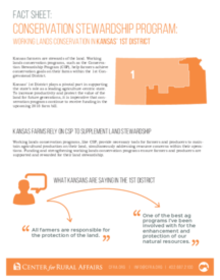Working lands conservation programs, such as the Conservation Stewardship Program, provide the necessary tools for farmers and producers to maintain agricultural production on their land, simultaneously addressing resource concerns within their operations. Funding and strengthening working lands conservation programs ensure farmers and producers are supported and rewarded for their environmental stewardship.
Farms in Nebraska, Iowa, Kansas, South Dakota, and North Dakota rely on the Conservation Stewardship Program to supplement land stewardship. To increase productivity and protect the value of the land for future generations, it is imperative that working lands conservations programs continue to receive funding in the upcoming 2018 farm bill.
What is the Conservation Stewardship Program?
Conservation Stewardship Program is a widely utilized land management tool focused on working lands in the U.S. The program encompasses 70 million total acres of productive agricultural and forest land nationally.
The program incentivizes conservation practices on Nebraska farms through education and contract payments. This provides farmers with foundational knowledge and funding to implement conservation practices in their farming operations. Conservation Stewardship Program promotes environmental stewardship and sustainability that not only benefits the productivity of the farm, but also improves water quality, air quality, and wildlife habitat.
The program effectively addresses each of these concerns by accepting applications on a year-round basis and developing individualized conservation plans for participants until funding is depleted.
Other fact sheets on the Conservation Stewardship Program: Nebraska's 1st District, Iowa's 3rd District, Iowa's 4th District, South Dakota, and North Dakota.


